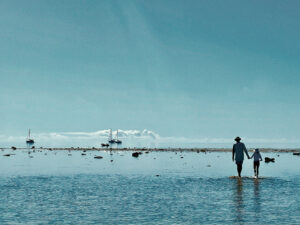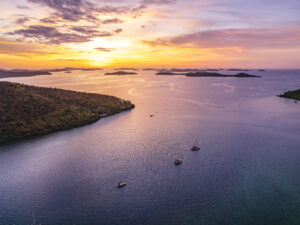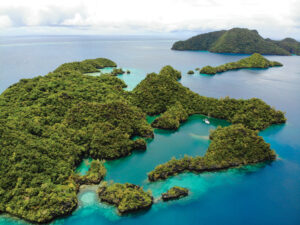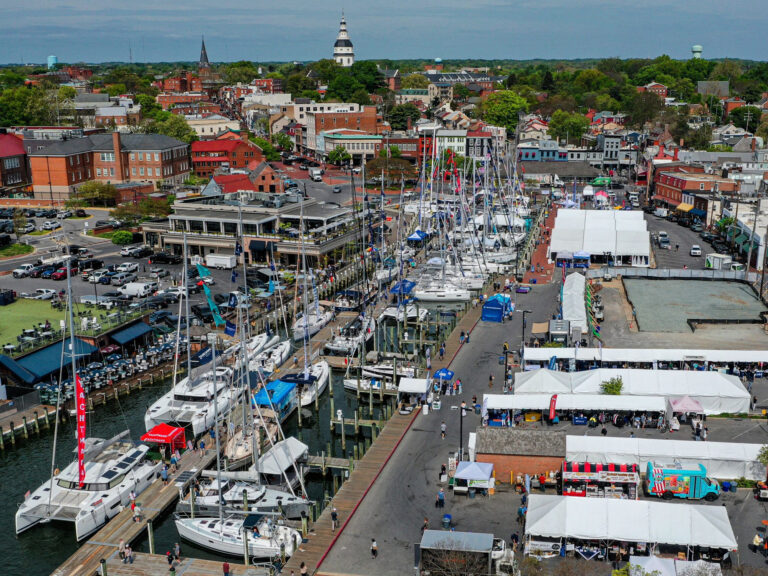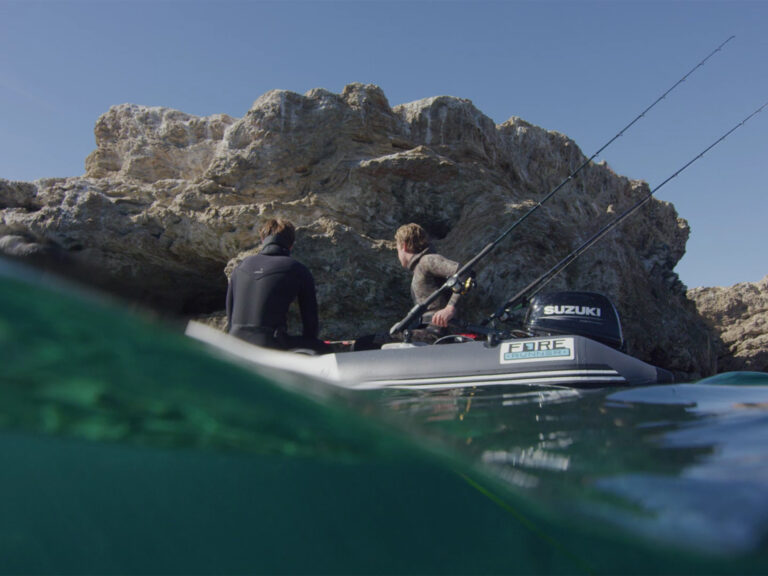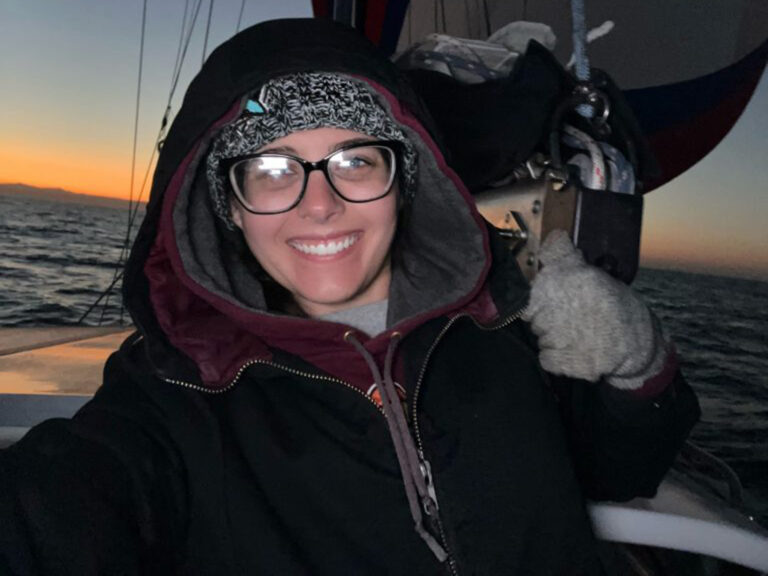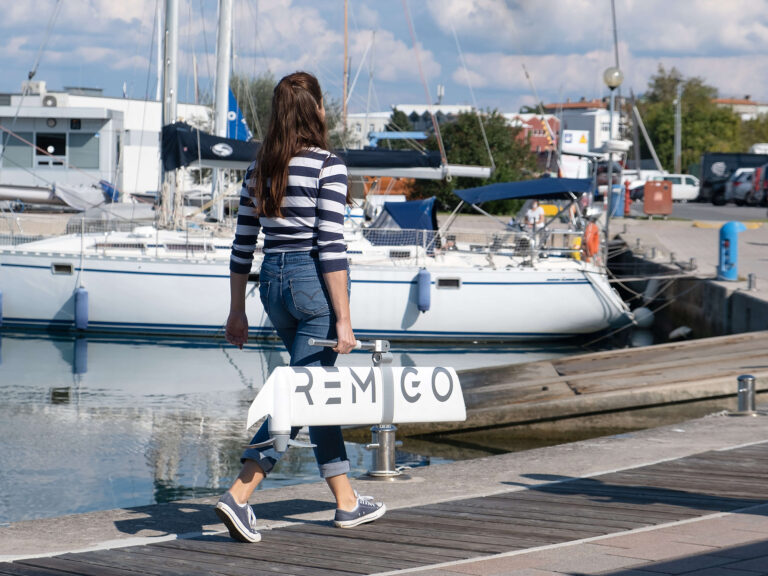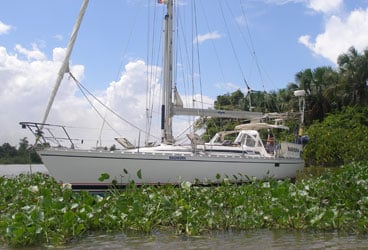
Bagheera
Sitting silently in the dinghy, with the painter tied to one of the gangly roots of the massive mangroves lining the Mánamo, my husband, Andy, and I gazed expectantly at the sky. It was 1800, dusk was descending, and we were waiting for birds. Was this a good place? We weren’t sure, but the white guano-covered trees on the island ahead, named Bird Island on our hand-sketched chartlet, were good signs. Suddenly, there were simultaneous flashes of phosphorescent red close ahead. The scarlet ibis had started to arrive.
Within seconds, another flock came, then another, until the sky was a mass of hundreds of birds whose wings were illuminated by the blaze of the setting sun as they wheeled in unison before descending on the dark-green foliage behind. Through the binoculars we could see them clearly, from their long, curved bills down to their spindly legs, their entire bodies a brilliant carmen red. For 20 minutes we watched, mesmerized, as the trees on the entire southern end of the island were sheathed in a scarlet glow, the ambience heightened by absolute silence. By 1830, the gloom of dark had descended, and the spectacle was over.
It was a dramatic ending to our first day on the serene Caño Mánamo, in the Orinoco Delta, and a contrast from the noisy frenzy of carnival on industrialized Trinidad and cruiser-crammed Chaguaramas Bay, which we’d left just the night before. We had nine days, a perfect period to explore the Mánamo, which, due to power lines, is only navigable by yacht for some 60 miles upstream. We’d found little cruising information, as few sailboats venture here, although a British boat had returned from the Orinoco just before we left Trinidad. Its crew generously shared their experiences.
One particular concern of ours was the depth at the entrance bar, as our 1985 Beneteau, Bagheera, draws seven feet three inches. Another was security. We were well aware of Venezuela’s political unrest and crimes against cruisers, from robbery to murder. We were delighted to learn from a Canadian couple that on both counts we were unlikely to have problems. They told us some notes were available from Jack Dausend, a former cruising station host in Trinidad for the Seven Seas Cruising Association. We also studied the charts, although these cover little more than the river entrance and a few miles upstream. “One has to feel one’s way upriver,” we were told. “Exploring the caños, or channels, unaided is part of the delta’s appeal.”
Stretching 140 nautical miles along the coast of eastern Venezuela, the fan-shaped Orinoco River Delta is crossed by a vast labyrinth of waterways that meander through 15,000 square miles of wetlands, freshwater swamp forests, towering palms, islands, and a fringe of mangroves before reaching the sea. A major distributary, the Caño Mánamo, borders its western edge and flows into the Gulf of Paria. Just 58 nautical miles from the popular boating center of Chaguaramas Bay, on Trinidad’s northwest coast, it’s easily accessed by a daysail south. Its lush and varied terrain includes numerous channels, and as the river changes from salt water to fresh, it offers a rich diversity of bird, animal, and aquatic life. Along its banks live the Warao Indians, whose lifestyle transports one back in time. It also has a few welcoming ecolodges for those who desire an evening ashore.
Our trip there began at 2100, after watching Trinidad carnival’s final grand parade. We were gliding across the Gulf of Paria with a light wind on our port quarter and a positive current. Bagheera‘s course was well to the west of layline to avoid the great cluster of oil platforms off Trinidad’s west coast and, in particular, the wellheads that are often unlit. As a sluggish sun burst into the sky, we arrived at the river bar on a rising tide. We’d been given some complex waypoints, but from the charts, the entry was straightforward. After crossing the shallows (as little as nine feet) we left the yellow oil platform ahead to port, then hugged the south side of the channel between Isla Cotorra and Isla Capure for maximum depth. To the southeast of our course, the charts marked a drying bank, and notes from cruisers warned us not to be fooled by the red and green markers identifying it—a statement that bothered me all week.
Soothing singing poured from a group of huts suspended over the water on stilts on the west side of the mouth of Caño Pedernales. After carnival, restful recordings were in order, although the characteristic beat of Latin America was at full volume on our return. Tying the dinghy at the north dock by a radio aerial, we were greeted cordially by a young man in uniform, whose Vigilantes Fluviales de Pedernales office was directly ashore. After studying our Trinidad clearance, boat documents, and passports carefully, the river policeman stamped our passports, clearing us in to cruise in the Delta. Previous cruisers had composed a simple form to ease the way back into Trinidad, which he happily signed and stamped, then invited us to explore the town. He spoke no English. Andy has some skills in Spanish, although sign language would’ve been adequate. There were no charges.
Pedernales is a small but significant fishing town with simple houses and lean-tos painted in bright tropical colors. The car-less streets were painted for carnival, with banners strung overhead. The few locals were relaxing, sitting in the ubiquitous plastic chairs outside their homes, chatting and watching the world go by and not particularly interested in us. Gradually, stores opened. They offered simple groceries, some produce, clothing, limited fuel, and Polar light beer; enticing aromas poured from the bakery. There were several restaurants.
On the northwest side we found a dock for the small ferries to Tucupita, the capital city of Delta Amacuro, one of Venezuela’s states, 68 miles inland. The ferries, generally long, wooden pirogues with outboards, take about five hours to transport people and goods upstream and are the river’s main traffic, besides fishermen. Close by there were several fishing jetties, where hundreds of small fish had been filleted, salted, and neatly laid out for drying before storing. Wandering near, we were offered shrimp from large tanks. About two and a half pounds cost the equivalent of US$3. We couldn’t resist two bags.
Bagheera was surging around on her anchor in a four-knot ebb on our return. We made a note to anchor on the north side of Caño Pedernales by Isla Capure when clearing out, where the current is less swift. It took far longer to head around the Pedernales peninsula than we anticipated, fighting the ebb and rounding the bank that stretches two-thirds of the way across the main channel to Isla Cotorra as well as downstream from the town.
Finally we entered Caño Mánamo, keeping two boat lengths off the northern Pedernales shore for the maximum depth, as it shallows quickly to the south. After anchoring, we fell on our bunk for a welcome siesta, but not before watching scarlet ibis wading on the banks, their long beaks probing the mud for crabs, crustaceans, mollusks, and the shrimp that give them their color. Two hours later, we were motoring fast to cover the 10 miles up to Bird Island before dusk, in time for an amazing scarlet-ibis viewing experience.
The charts end about 11 miles farther upstream and show several shallows with no soundings. Inevitably, we’d go aground. Fortunately, our cast-iron keel is quite practiced at barreling through mud with no adverse affects, so we weren’t too concerned except to travel on a rising tide, although at times the tide could only be estimated from the day before.
We’d passed some open, palm-covered shelters, but four miles upstream from Bird Island we came to our first Warao village. Several canoes came to greet us, and I recalled that “warao” means “canoe people.” Basic dugouts, they were mostly paddled in the traditional way, but a few had outboard engines that are sometimes government-funded for fishing. Numbering some 25,000, the Warao are Venezuela’s second-largest indigenous group, and they’ve inhabited the Delta for more than nine centuries.
Mothers with young babes at their breast and children surrounded us now, small, poorly clad people with dark hair and welcoming smiles. I quickly tied fenders as they reached up to hold on to our topsides. Having heard much about their trading, I expected them to offer goods, but none did. They just seemed curious, and we were their entertainment that day. Communication was in sign language, as they didn’t respond to our Spanish. Warao is a unique Amerindian language with no formal written tradition. Wanting to make the most of the flood, we soon headed off. Again there were big smiles as they waved good-bye.
We were now at the confluence of the Mánamo and two short distributaries to the west. Should we continue south, where the channel widened but definitely shallowed, or take the channel north of some small islands to the west bank, which was narrow but looked deeper? We chose the latter, enjoying winding our way through lush overhanging vegetation, often spotting scarlet ibis roosting with white egrets in the branches. We were almost through when_ Bagheera_ slowly ground to a standstill, her keel sliding to a stop in the gooey mud. We’d cut the corner too closely, a reminder to keep to the outside of bends.
Keen to get up to fresh water and its associated flora and fauna, we continued south past other islands, finally anchoring close to Boca de Tigre Lodge. Immediately beside us, there arrived dugouts and the lodge’s metal canoes laden with locals, smiling and holding up wares. We found similar scenes at other lodges we explored. These destinations provided a ready market of visitors, and the locals had developed their trade; with sign language, they bargained hard.
Following advice, I had shirts and shampoo, thread and fishing hooks, pens and colored paper, and more at the ready. Their goods were woven baskets patterned in pink and green, lidded pots and mats, and much seed jewelry. I liked a small bowl and offered a designer blouse, but the woman indicated she wanted six shirts and shampoo! Of course, my instinct was to give it to her—these people appear so poor—but we’ve always believed an exchange should have some realistic value, so we settled for much less, with some mats included.
Their typical Warao village was close by. We passed several villages that varied in size. Built high on stilts along the riverbank, these palafittes are connected by a planked walkway with occasional logs to the water, where they secure canoes. Generally about 20 by 30 feet in size with a clay firepit, palafittes have branches woven together for floors, thatched roofs, and no walls. Each is crowded and home to extended families that follow a matrilocal social system in which the bridegroom moves to his new wife’s home.
Clothes hang from the rafters, hammocks are the only furnishing, and days are spent child minding, fishing, hunting, and gathering meager crops and medicinal herbs. I was pleased to find most villages have small elementary schools furnished with plastic desks and chairs. Older students have to go to Tucupita, although it appears that much of a teenage girl’s time is spent caring for younger siblings while the boys go fishing.
Going ashore in the dinghy, we were welcomed at Boca de Tigre’s dock and shown around. Built in 1993, it was the first of the lodges in the area, built with high, airy buildings. Carlos, the owner, soon returned from piranha fishing along with his teenage son and friends, all visiting from Venezuela’s capital city, Caracas, for a week’s holiday. Carlos and a friend spoke English, and our first question was about these aggressive, flesh-loving fish. “Don’t swim in the water close to the bank,” Carlos said, “Otherwise, you’ll be fine, unless you’re bleeding!” A good thing to learn!
Before we knew it, we were Carlos’ guests for two days. The lads’ enthusiasm was boundless, and we were soon sitting at the long, convivial dining table with the family and lodge guests for a delicious fish dinner, then dancing the mari-mari to the four-string guitars of a local musician and his son; they apologized that it wasn’t the traditional violin. After donning long rubber boots next morning, we motored up a small caño in a narrow dugout, ducking under the trailing vines until we reached the path for a jungle walk.
Brandishing his machete, José, our guide, showed us how the Warao live from the forest. He pointed out the “canoe” trees, explaining that the center is burned out and the top widened in the heat. We sampled a refreshing liquid that we let drip down our throats from a cut branch, as well as heart of palm and local fruit.
He explained how the common moriche palm, also known as the Tree of Life, is used for house building, particularly the thatch; how its fibers are used for weaving hammocks; how its cassava pulp is made into bread; how the knobby nuts provide a jelly that’s high in electrolytes. “The locals’ Gatorade,” the boys told us, grinning as they translated. Baskets were precisely fashioned and hats created from a stretchy bark traditionally used for men’s apparel. Finally José dug out a bulging gray moriche worm, which he declared “a nutritious delicacy!” After cutting off its head and extracting the guts, he slowly munched and swallowed it—but not with an entirely ecstatic look of pleasure, I noted.
Our final stop was at a demonstration village being built by Carlos opposite the lodge. Earlier, he’d shown us the professional plans, explaining that he’d first come to the Delta searching for oil and had immediately become enchanted by the area but was acutely aware of the poverty of its people. Along with the lodge, he built a school and funded its teachers and pupil transportation.
He’s also raised money to build a village in which the Warao can learn how to lead a healthier, more productive life without compromising their culture. Currently, children aren’t named until they’re 3 years old because they aren’t expected to live. Life expectancy is just beyond 40, and many Warao suffer from tuberculosis and kidney ailments from the constant damp. The village will have traditional homes and a shaman as well as a doctor. Health and hygiene will be emphasized, along with skill building and the rewards of productivity. The project is particularly significant because despite the region’s huge oil reserves, legislation has preserved the Delta for its indigenous people.
We were now in fresh water. Mangrove forests had been left behind, and vegetation was lush with jungle fauna and flora. For the next few days, we explored and anchored in smaller caños, and Bagheera was frequently surrounded at dawn by rafts of the blue flowers of water hyacinths, when the forest came alive.
Easy to identify were the howler monkeys, snorting tapirs, croaking frogs, and pairs of parrots. There were abundant gold and blue macaws, toucans with their distinctive red and yellow curved bills, kingfishers, hoatzins, and weavers flying from bell-shaped, dangling nests.
With 190 species of mammals, 674 species of birds, and 80 reptiles in the Delta, there was plenty to look for, and the binoculars were always on deck, especially at dawn and dusk.
Taking Carlos’ advice, we anchored at bocas, the mouth or confluence of rivers, and were delighted by twice-daily visits by pink Amazon River dolphins. These friendly mammals, with a brain capacity 40 percent larger than that of humans, have lived in harmony with the people of the Orinoco for centuries.
We visited three other lodges: Mis Palafitos, Orinoco Bujana, and the more resort-oriented Orinoco Delta, and enjoyed their different styles. All guests are brought in by boat on all-inclusive packages that maximize their time.
It had been an amazing week, connecting with nature and a non-industrialized people, a reminder of the rewards of cruising off the beaten track. Slowly we made our way north with the current. We couldn’t resist a last night with the ibis, then left early the next morning to clear out with the authorities and head to Trinidad on the ebb. I had one more mission: to leave between the red and green marker buoys even though all charts marked it as a drying bank. Sand banks continuously move, I rationalized. We went through the channel just after the bottom of a spring tide and never had less than 15 feet below us. Presumably dredged for oil-platform access, the entry marker was almost exactly in the same position as on our Nobeltec chart.
A racer and a cruiser, Liza Copeland has sailed more than 140,000 miles. She’s a lecturer and the author of three cruising narratives as well as Cruising for Cowards, co-authored with her husband, Andy.
Hit the jump for waypoint information about cruising the Orinoco_
_
Orinoco River Delta Waypoints
Note: These are approximate
The buoyed entry channel at Manamo
Orange entry marker 10° 04.29N, 62° 07.45W
1st red marker 10 ° 04.19N 1st green marker 10° 03.78N
62° 07.86W 62° 08 07W
2nd 10° 03.94N 2nd 10° 03.77N
62° 08.55W 62° 08.55W
3rd 10° 03.79N
62°09.15W
Leave yellow oil platform at 10° 01.69N 62°11.66W 150 yards to port
Customs Pedernales 09° 58 23N 62° 15 05W
Note: The bank between Pedernales and Isla Cotorra has extended.
Keep close to the Pedernales side when entering the Caño Mánamo.
Bird Island anchorage 09° 47.65N 62°16.68W (island south of its charted position)
1st village 09°44.40N 62°17.23W
Lodges
_Boca de Tigre Lodge _ 09° 34 50N 62° 25.55W
(Transit the east side of this island, the west channel is shallow)
Orinoco Bujana Lodge Turn-off from main river 9° 28N, 62° 24.20W and take first southerly caño. Entrance is shallow_._
Orinoco Delta Lodge Turn-off from main river 09° 25.30N, 62° 24.74W
Lodge is at 09° 22 55N 62° 22 59W
Mis Palafitos Turn-off from main river is at 09° 26.8N 62° 24.4W by pink building.
Lodge is at 09° 25.11N 62° 27.65W

